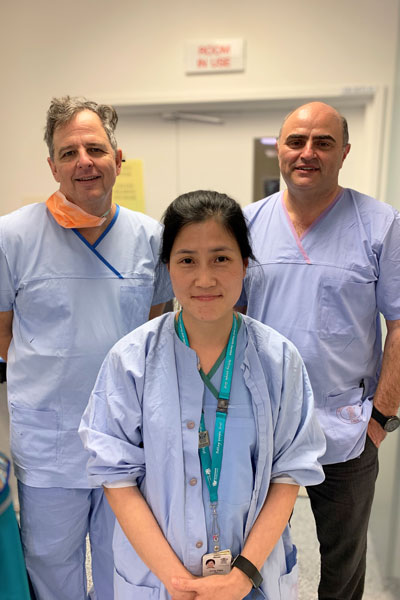
RBWH Thoracic Physician Dr David Fielding, Clinical Nurse Jung Hwa Son and Thoracic Consultant Farzad Bashirzadeh.
New robotic technology at RBWH is allowing clinicians to diagnose lung cancer earlier than ever before, meaning patients can commence life-saving treatment sooner.
The bronchoscopy robot is the first of its kind in Australia and is used to further investigate potential lung cancer nodules located deep inside the lungs that have been identified in CAT scans.
The bronchoscopy robot has a much smaller camera than previous technology, which means it can reach and diagnose potentially cancerous nodules as small as 1cm using ‘sat-nav’ style vision. Before the introduction of this technology, it was very difficult for thoracic medicine specialists to sample nodules less than 10cm in size.
The RBWH team was responsible for the world-first first in-human study in 2018, and the technology is already seeing excellent success in identifying cancerous nodules overseas. As part of an ongoing prospective study, it is hoped the robot will provide better health outcomes and more treatment options and choices for hundreds of Queenslanders every year.
RBWH Thoracic Physician Dr David Fielding, alongside a dedicated team of clinicians, has led the research and implementation of the technology at the hospital and is thrilled to see it come to fruition as part of an ongoing registry study.
“Having the ability to offer this technology at RBWH puts us at the cutting edge of clinical lung cancer diagnosis and management through allowing us to diagnose lung cancers earlier,” said Dr Fielding.
“This is a culmination of a series of technological advances that have been combined into one device.
“As a clinician, the bronchoscopy robot allows us to diagnose nodules we are concerned about which previously would have been too small to check.
“It brings forward a potential diagnosis using a safe technique and provides us with an opportunity to bring more certainty and treatment options to patients.”
Well done to the team for making this technology a reality at RBWH.